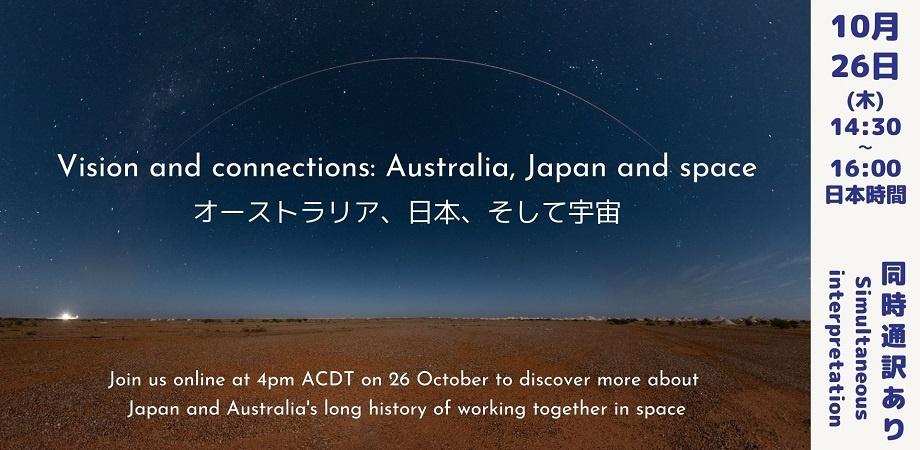《オンライン》 |
《前夜祭》 |
《実地開催》 |
26A1410月26日(木)14:30-16:00
オンライン
Vision and connections: Australia, Japan and space
Australian Space Agency
場所:オンライン
企画概要

Why do we go to space and what benefit is there for society in doing so? Japan and Australia have a long history of working together towards space projects. Space is a great enabler for society that affects our day-today life in many ways. Join this session to learn about the history and potential future for Japanese/Australian collaboration in space, space education opportunities in both nations, and to discuss ideas about how and why we undertake space activities and how doing so benefits humanity.
(日英同時通訳あり)
出展レポート
企画概要の補足
●New and exciting upcoming JAXA MMX mission will seek to take a sample from Phobos, one of the Martian moons and return it to Earth. Australia will be the landing site for the sample return. This mission is complex and requires cutting edge mission design and technology. Many of the technologies developed for space are transferable to improving our quality of life, propagating throughout society. Additionally, space-based services provide many benefits to us on Earth , many of which we do not often identify or appreciate.
●These themes are explored further through the lens of why space is important, the benefits we gain from it in society, how the public can be involved in space activities, and the collaborative relationship of Japanese and Australian activities.
●The workshop begins by an acknowledgement and opening remarks from Ambassador Hayhurst, the Australian ambassador to Japan. The Ambassador speaks about our joint prospectus and historic relationship.
●MMX is the first topic, where an overview of the mission is provided followed by an example of space education through an interactive game ( https://stage.tksc.jaxa.jp/eduweb/mmxentest/). This game touches on space mission and spacecraft design elements whereby players need to select components to complete the mission.
●A brief overview of historic activities between Australian and Japan is then discussed, including:
・Australian reliance on Himawari satellite data has been supporting Australia since 1977.
・Australia also received remote sensing data from Japan’s Marine Observation Satellite-1 (MOS-1) between 1987 – 1995.
・In 1986 and 1988 Tidbinbilla and a Japanese radio telescope were used in conjunction with NASA's Tracking and Data Relay Satellites (TDRS) to create a Very Long Baseline Interferometer (VLBI) with a baseline 2.16 times the diameter of the Earth to study remote radio sources in deep space. This was a precursor to Japan’s VSOP (VLBI Space Observatory Program, also known as HALCA) satellite, which operated between 1997 and 2005.
・Australia has served as a test and landing location for several Japanese space projects since the 1990s.
・Thirteen tests of the ALFLEX (Automatic Landing Flight Experiment) technology demonstrator vehicle for Japan’s HOPE spaceplane development program were conducted at Woomera in 1996, with further landing test of the High-Speed Flight Demonstration (HSFD) vehicle undertaken at Christmas Island in 2002.
・Japan generously provided the launch of Australia’s technology demonstrator satellite FedSat (Federation Satellite) as a gift to Australia in celebration of the Centenary of Australian Federation. FedSat (Australia’s first locally-developed satellite since 1970) was designed to showcase Australia’s growing capabilities in the field of space technology.
・During this era, Japan, the US and Australia begun holding Trilateral Strategic Dialogue (TSD) towards partnership for maritime security in the region with a trilateral Space Security Dialogue being held since 2011.
●Significant emphasis is placed on the upcoming Artemis missions and the role that both Japan and Australia may play in supporting a sustainable presence on the moon in the future.
●A Himawari satellite viewer activity is then conducted ( http://satview.bom.gov.au/) in which participants can visualize satellite data. Participants are asked to brainstorm how and why these data are important and how they can be used in society. The activity has participants visualizing light over several wavelengths such that we understand how different wavelengths can help identify clouds, moisture, surface heat, and extreme weather, We then investigate how these data can be combined with other data (such as GPS) to overlay landmarks, cities, roads and coastal boundaries in order to get a more accurate representation of local conditions.
●Participants were then asked to contribute to a word cloud (see keywords section below for a summary of responses) to answer the question: Why does space matter? Together we discuss some of the ideas the participants have about the significant role that space plays in society.
●We gain an understanding of the space / earth environment by a demonstration activity of Saber Astronautics’ TAROT software ( https://tarot.saberastro.com/). Participants are guided through using this software to identify object on-orbit, understand what type of objects are orbiting the Earth and where they are located, as well as the growing challenge of manage space debris (a consideration in which responsible space operators are looking at mitigation and reduction methods), before locating the Himawari-8 satellite
●The next section addresses space education in Australia, highlighting both local initiatives and those in collaboration with JAXA:
●One Giant Leap
・SEEDS IN SPACE
・Seeds of Australia’s national floral emblem, the Golden Wattle, were launched into space in December 2020 for a seven month journey as part of the ground-breaking ‘What’ll Happen to the Wattle??!’ program.
・The ‘What’ll happen to the Wattle’ program is a collaboration between the One Giant Leap Foundation, the Australian Space Agency and the Japan Aerospace Exploration Agency (JAXA).
・The Golden Wattle seeds called the International Space Station ‘home’ until their return to Earth in July.
・Since then, the seeds have been distributed to more than 300 locations around Australia to grow, with data about the plants uploaded to the What’ll Happen to the Wattle app including schools and community groups.
・A guidebook was produced to lead science teachers experimenting with the seeds in the classrooms. Partcipants also had the chance to take part in webinars , gatherings and virtual meetings to learn more and discuss their findings
・ASIAN TRY ZERO-G
・Asian Try Zero-G 2023 is an exciting ‘out of this world’ competition where students are able to propose an experiment or exercise that could be selected to be conducted by JAXA astronauts in the Kibo module of the International Space Station.
・The Asian Try Zero-G competition has been created by the Japan Aerospace Exploration Agency (JAXA) to promote crewed space experiment activities aboard Kibo.
・Students are asked to design and submit proposals for simple microgravity experiments or exercises that can be easily performed onboard the ISS.
・Australian National University Aerospace Engineering student Shingo Nishimoto had his experiment selected by a distinguished panel of space professionals
・The experiment looks at the rotating motion of chopsticks for a long duration under the zero gravity environment and will help us to understand whether the theoretical expectation is correct
・KIBO-RPC
・The Kibo Robot Programming Challenge is an educational program in which students solve various problems by programming free-flying robots (Astrobee and Int-Ball) in the International Space Station (ISS).
・The Kibo-RPC will inspire students to develop their educational and professional goals to a higher level.
・Participants will have the opportunity to learn cutting-edge methodologies and hone their skills in science, technology, engineering, and mathematics through this program.
・The Kibo-RPC will also expand international exchange by encouraging students to interact with other participants from around the world.
・This year was its fourth iteration, with the team from Taiwan coming in first place followed by Singapore as runner-up
●Makers Empire
・KIDS IN SPACE – MAKERS EMPIRE
・Schools selected for Kids in Space receive a $6,000 package including:
・2+ teachers will participate in the Makers Empire Learning By Design program with guest speakers from the space industry.
・1 x 12 months Makers Empire School Subscription (3D design software, teacher dashboard, 130 curriculum-aligned lesson plans, built-in assessment, online professional development (PD), ongoing support, updates and maintenance).
・1 x brand-new space-themed challenge course.
・1 x Flashforge Adventurer 4 3D printer and 5 rolls of PLA filament.
・Print credits to Makers Empire 3D print bureau service.
・Hospitality for PD days and Showcase Days in each state.
・Around 10,000 students were involved, working on space projects over 2 terms creating over 500,000 3D designs.
・Hundreds of teachers participated in professional development focusing on design thinking with space as the context and special guests from local space industries and educators from the Australian Space Discovery Centre.
・By focusing on teacher professional development we increase impact over multiple years and more kids
・Teacher development was held over 2 days and included an introduction to Makers Empire and the Kids in Space Challenge Course, maker pedagogies, Design Thinking and Design thinking in the curriculum from our learning experts, live video calls with guest speakers from the Australian Space Agency, sharing of potential project ideas and an introduction to 3D printing. PD days in some states and territories also included additional guest speakers from the space industry, visits to local space museums and training facilities, and tours of working satellite facilities.
・70 schools participated grouped by state/territory (almost 500 EOIs received)
・Showcase days in every state included special guests: Dara Williams (Deputy Head of the ASA), Enrico Palermo (Head of the ASA), Hon. Mick Gentleman (Minister for Advanced Technologies and Space Industries), Hon. Stephen Dawson (Minister for Innovation and the Digital Economy), Hon. Susan Close (Deputy Premier), representatives from education departments, KBR, Airbus, National Youth Science Forum, Questacon, CSIRO, Space Defence, iLaunch, Fleet, Inovor Technologies, Equatorial Launch Australia, Catholic education offices, AMDA, Toyota, ICRAR, Perth Observatory, Scitech, QL Space, and more.
・During the course of the event, students both presented their projects to booth visitors and also visited other booths. As they visited each booth, students were tasked with either asking a question or delivering some helpful feedback and receive a stamp in a provided passport for their efforts. They also had to decide which of the other booths they wanted to award one of their three tickets for the student-voted peer prize.
●Tying all of the previous topics together, we provide information on upcoming Australian/Japanese collaborations including the Asia-Pacific Regional Space Agency Forum to be held in Perth, Australia in 2024. Attendees are asked what they would like to see from events such as this and encouraged to give feedback around other collaborations
●The workshop is concluded with an overview of topics covered and space education resources, as well as a Question and Answer segment.
話し合った未来像
・A future where Australia and Japan continue to enhance their relationship in space activities whereby significant benefits from these activities transfer into society and enhance our quality of life.
セッションでの意見、論点
・Space provides a platform for our countries and peoples to cooperate, trade and thrive. It helps toward shaping a region that is open, stable, and prosperous. A predictable region, operating by agreed rules, standards, and laws.
・We have also been hard at work inspiring young people to pursue a career in space, as well as engaging the Asia-Pacific region towards greater space cooperations.
・Collaboration in our region should not only support the exploration of space, but one that supports more developing nations within the region to access space technology. We know space technology is critical to addressing key issues such as climate change, access to medical care and education, as well as providing reliable communication.
・There are immense opportunities for us to continue to build a strong framework of collaboration to ensure space technologies are accessible and have a real and positive impact on the planet, in helping people, and promoting prosperity in the region.
・It’s the business-to-business partnerships, the research opportunities, the ability for our people to learn from the world’s best and to teach them too.
セッションで出たキーワード
create、important、earth 、Study、Communications、Facilitates、innovation、Rockets、view point、space exploration、Philosophy、Observation、Science、Health、Security、PNT、Solutions、Remote sensing、Collaborate、Japan、Australia、Space、Education、Meaningful、Benefits、Engineering、Explore


